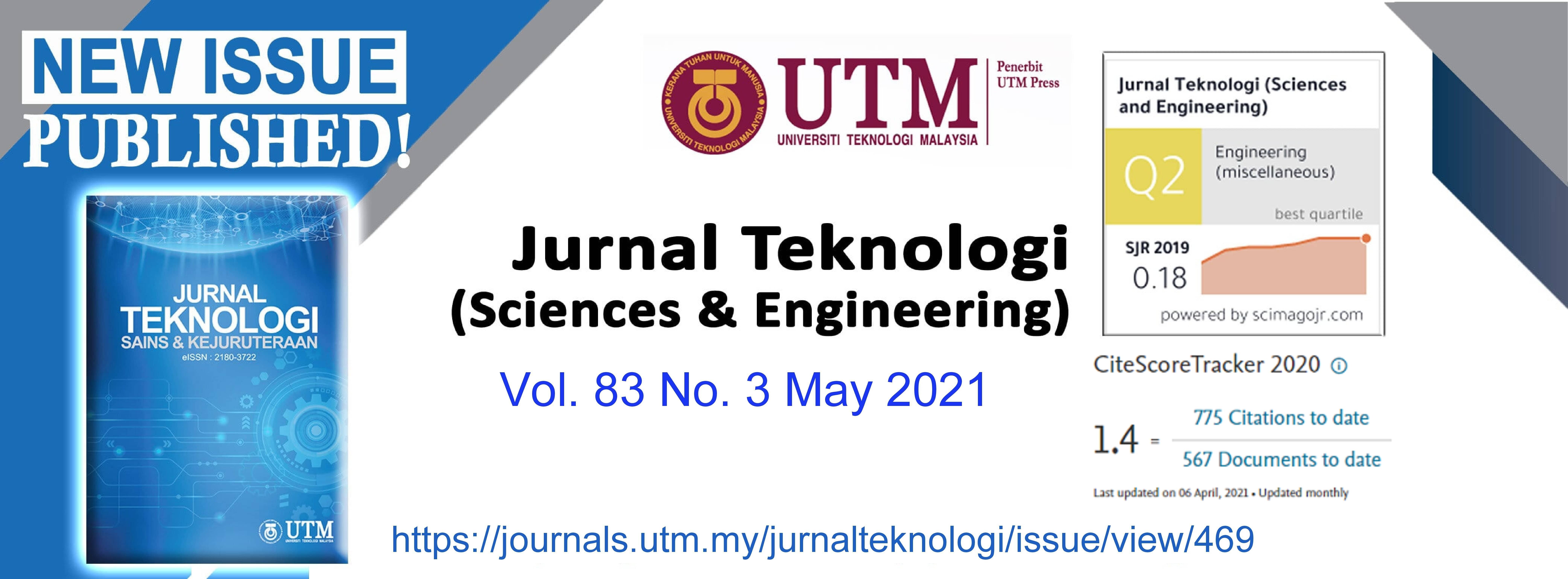NUMERICAL SIMULATION OF MUDFLOW WITH A TWO-DIMENSIONAL DEPTH-AVERAGED MODEL
DOI:
https://doi.org/10.11113/jurnalteknologi.v83.14069Keywords:
Mudflow, Herschel Bulkley model, viscoplastic fluid, dam-break flow model, shallow water equationAbstract
This study is motivated by the need to mitigate damages caused by mudflow disaster, which is occurring frequently due to intensive forest clearing and uncontrolled land use at highland. Numerical modelling of mudflow is challenging as the propagation speed and rheological behavior of the flow relies on the accuracy of the numerical scheme and choice of rheological model. In this study, a two-dimensional depth-averaged model was developed to simulate a simplified mudflow event. In order to capture shock in mudflow, the finite volume method (FVM) with third order accurate Monotonic Upstream-centered Scheme of Conservation Laws (MUSCL) scheme was adopted in the numerical model and the model was verified against a benchmark partial dam-break problem. By assuming that the mudflow has high amount of fine mud suspension. the rheological model was represented by a simplified Herschel-Bulkley model. Numerical results showed that the Herschel-Bulkley model could reproduce the viscoplastic behavior of mudflow well, especially in the estimation of final longitudinal flow spreading (2% difference compared to experimental value) and depth of peak wave (8.8% maximum difference). The robustness and stability of the model was demonstrated by simulating a simplified mudflow event with obstacles.
References
Costa, John E. 1984. Physical geomorphology of debris flows. Developments and Applications of Geomorphology, Berlin: Springer-Verlag.
DOI: https://doi.org/10.1007/978-3-642-69759-3_9
Jamaludin, S., Abdullah, C. H. and Kasim, N. 2014. Rainfall intensity and duration for debris flow triggering in Peninsular Malaysia, Landslide Science for a Safer Geo-environment. 1:167-174.
DOI: https://doi.org/10.1007/978-3-319-04999-1_20
Schamber, D. R. and MacArthur, R. C. 1985. One-dimensional model for mudflows, Proceeding of the Conference on Hydraulics and Hydrology in Small Computer Age, ASCE. Orlando, Florida. 2: 1334-1339.
O’Brien, J. S. and Fullerton, W. T. 1990. Urban floodplain and alluvial fan stormwater modeling, Urban Hydrology, Proceeding, 26th Annual AWRA Conference, Denver, Colorado.
Takashi, T. and Tsujimoto, H. 1985. Delineation of the debris flow hazardous zone by a numerical simulation method, Proceeding of the International Symposium on Erosion, Debris Flow and Disaster Prevention, Tsukuba, Japan. 1985. 457-462.
Laigle. D. and Coussot. P. 1997. Numerical modeling of mudflows, Journal of Hydraulic Engineering, ASCE. 123: 617-623.
DOI: https://doi.org/10.1061/(ASCE)0733-9429(1997)123:7
(617)
Huang X. and Garcia, M. H. 1998. A Herschel-Bulkley model for mud flow down a slope. Journal of Fluid Mechanics. 374: 305-333.
DOI: https://doi.org/10.1017/S0022112098002845
Fernández-Nieto, E. D., Gallardo, J. M. and Vigneaux, P. 2014. Efficient numerical schemes for viscoplastic avalanches. Part 1: the 1D case. Journal of Computational Physics 264: 55-90.
DOI: https://doi.org/10.1016/j.jcp.2014.01.026
Ionescu, I. and LupaÅŸcu, O. 2016. Modeling shallow avalanche onset over complex basal topography, Advances in Computational Mathematics 42, 1.
DOI: https://doi.org/10.1007/s10444-015-9407-2
Tannehill. J. C., Anderson. D. A. and Pletcher. R. H. 1997 Computational fluid mechanics and heat transfer. United States: Taylor and Francis.
Griffiths, Graham W., and William E. Schiesser. 2009, Linear and nonlinear waves, Scholarpedia 4.7: 4308.
DOI: https://doi.org/10.4249/scholarpedia.4308
Pereira, F. F., Fragoso Jr, C. R., Uvo, C. B., Collischonn, W., & Motta Marques, D. M. L. 2013. Assessment of numerical schemes for solving the advection–diffusion equation on unstructured grids: case study of the GuaÃba River, Brazil. Nonlinear Processes in Geophysics, 20(6): 1113-1125.
DOI: https://doi.org/10.5194/npg-20-1113-2013
Coussot. P. and Piau. J. M. 1994. On the behavior of fine mud suspensions, Rheologica Acta. 33: 175-184.
DOI: https://doi.org/10.1007/BF00437302
Cochard. S., and Ancey. C. 2009. Experimental investigation of the spreading of viscoplastic fluids on inclined planes, Journal of Non-Newtonian Fluid Mechanics. 158: 73-84.
DOI: https://doi.org/10.1016/j.jnnfm.2008.08.007
Van Leer. B. 1979. Towards the ultimate conservative difference scheme. V. A second-order sequel to Godunov's method. Journal of computational Physics, 32(1). 101-136.
DOI: https://doi.org/10.1016/0021-9991(79)90145-1
Toro. E. F. 2009. Riemann solvers and numerical methods for fluid dynamics: a practical introduction. United States: Springer.
DOI: https://doi.org/10.1007/b79761
Akoh, R., Ii, S. and Xiao, F., 2008. A CIP/multiâ€moment finite volume method for shallow water equations with source terms. International journal for numerical methods in fluids, 56(12), 2245-2270.
DOI: https://doi.org/10.1002/fld.1616
Erduran, K.S., Kutija, V. and Hewett, C.J.M., 2002. Performance of finite volume solutions to the shallow water equations with shockâ€capturing schemes. International journal for numerical methods in fluids, 40(10),1237-1273.
DOI: https://doi.org/10.1002/fld.402
Caleffi. V., Valiani, A., and Zanni, A. 2003 Finite volume method for simulating extreme flood events, Journal of Hdyraulic Research, 41(2): 167-177.
DOI: https://doi.org/10.1080/00221680309499959
Schippa. L., and Pavan. S. 2011. Numerical modelling of catastrophic events produced by mud or debris flows, Journal of Safety and Security Engineering, 4: 403-423.
DOI: 10.2495/SAFE-V1-N4-403-422
Puay H. T. and Hosoda T. 2007. Study of characteristics of inertial and viscous flow regions by means of dam break flow with finite volume, Journal of Applied Mechanics, JSCE, 10: 757-768.
DOI: https://doi.org/10.2208/journalam.10.757
Puay H. T. and Hosoda T. 2010. Fundamental study of Bingham fluid by means of dam-break flow model, Journal of Hydraulic Engineering, JSCE, 54: 1177-1
Downloads
Published
Issue
Section
License
Copyright of articles that appear in Jurnal Teknologi belongs exclusively to Penerbit Universiti Teknologi Malaysia (Penerbit UTM Press). This copyright covers the rights to reproduce the article, including reprints, electronic reproductions, or any other reproductions of similar nature.
















